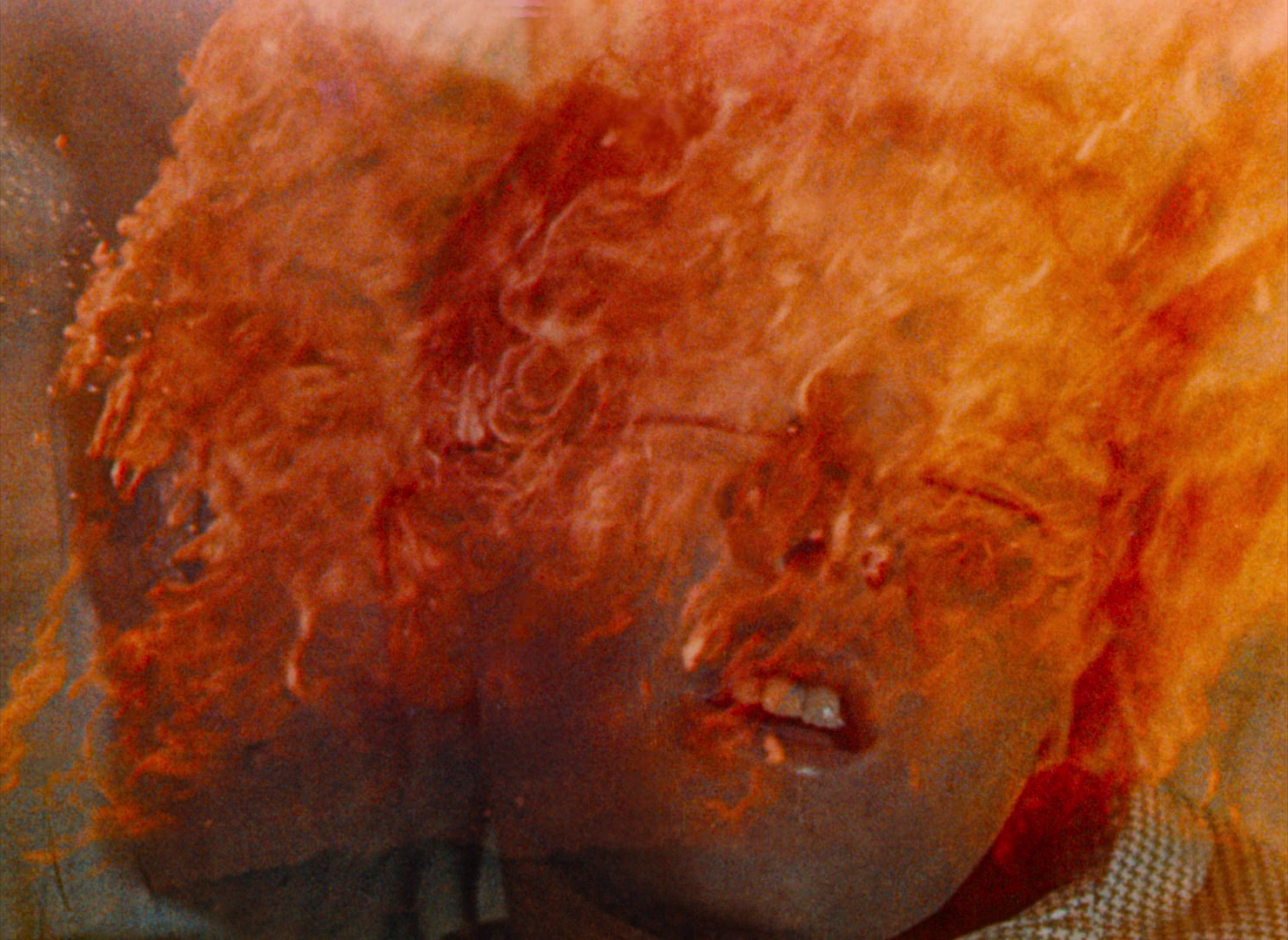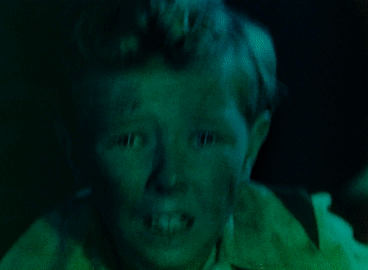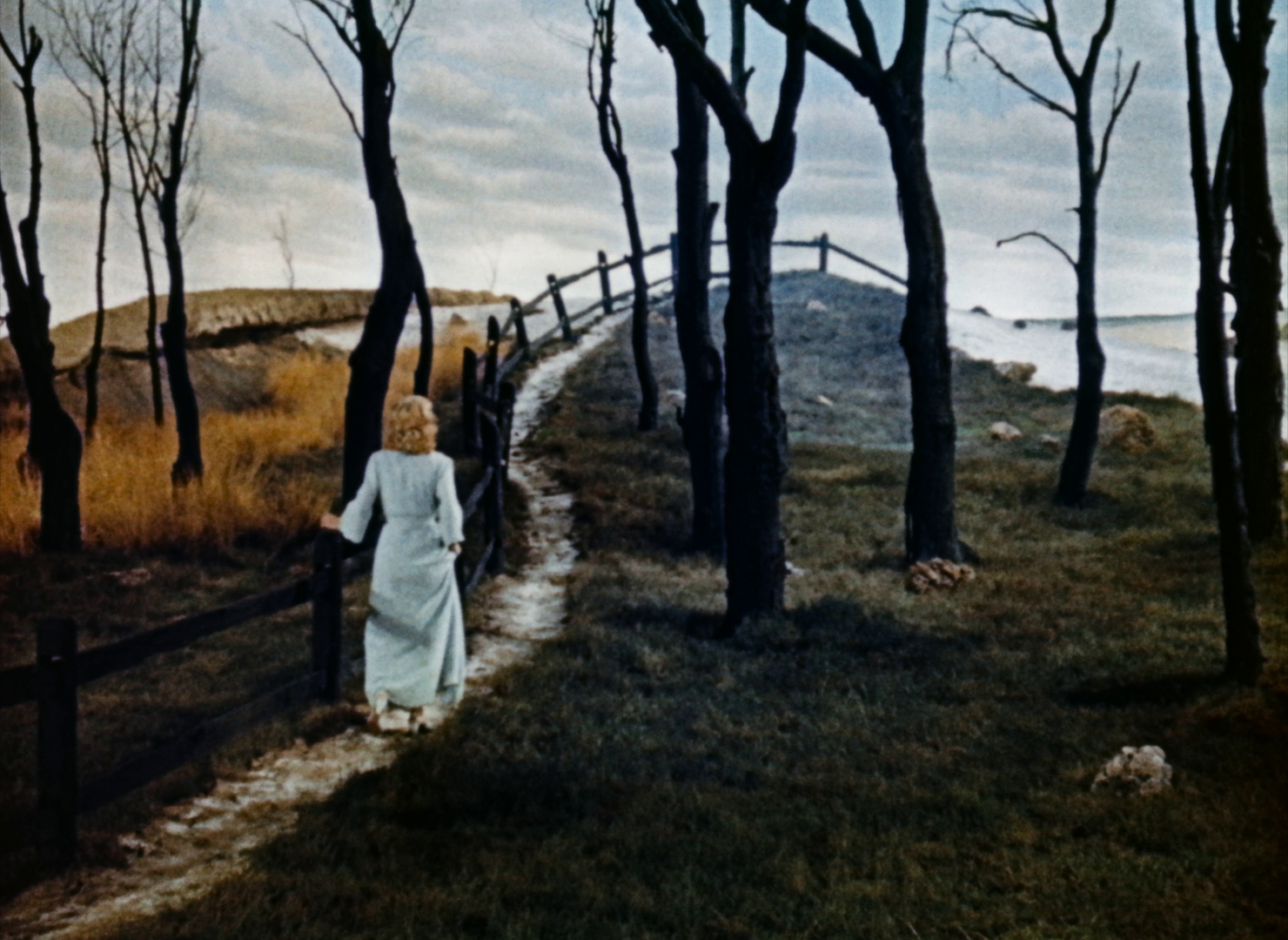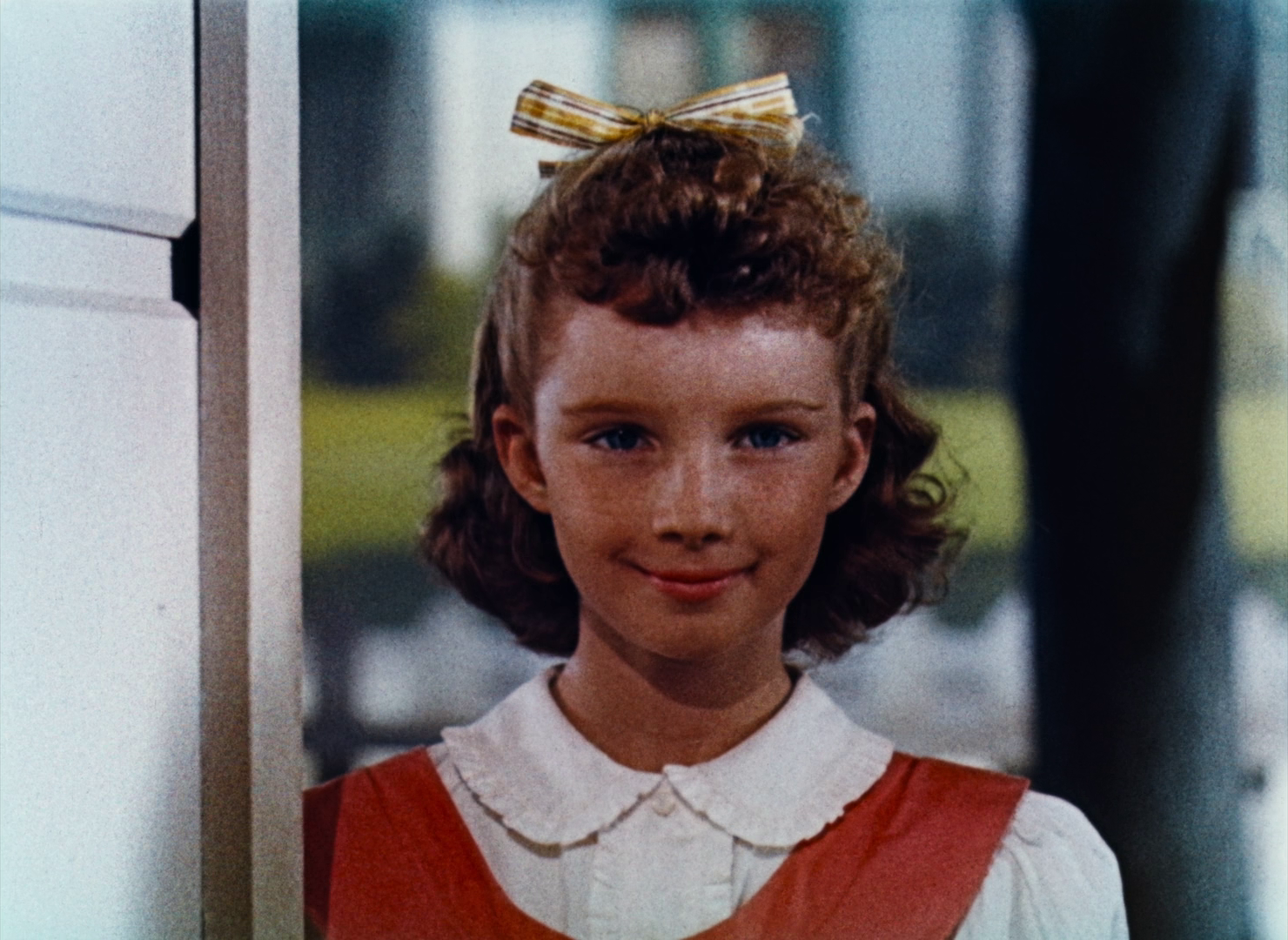 Please note that all framegrabs are from the 1080p version
Please note that all framegrabs are from the 1080p version
***½/**** Image A Sound A Extras A-
starring Helena Carter, Arthur Franz, Jimmy Hunt, Leif Erickson
screenplay by Richard Blake
production designed and directed by William Cameron Menzies
by Bill Chambers Predating Jack Finney’s novel The Body Snatchers by two years and Don Siegel’s seminal film adaptation, Invasion of the Body Snatchers, by three, William Cameron Menzies’s Invaders from Mars makes for an apt precursor in featuring a child protagonist and beginning at the dawn of an invasion instead of the usual in media res. When his alarm clock reminds him in the middle of the night to check out “Orion in its zenith,” little David MacLean (Jimmy Hunt) accidentally rouses his father, George (Leif Erickson), who is careful not to discourage the curiosity of a fellow “scientist” while tucking his son back into bed. David is awakened again by a commotion outside, and from his bedroom window sees a flying saucer disappear below the horizon. Dad agrees to check it out, which is of course not the wisest idea, yet his respect for his son’s intelligence is touching. While a twist ending recontextualizes this moment, suggesting it may have been wishful thinking on David’s part, that’s touching, too: Here’s a movie where the child’s fantasy of saving the world isn’t about demonstrating feats of heroism beyond his years, but about adults giving him the benefit of the doubt.
George returns home the following morning with a new, disturbingly chilly mien, and David’s whole world collapses like a soufflé. Although it’s tempting to read all of Invaders from Mars as a metaphor for the loss of innocence, this particular beat, at least, resonates as something else: a glimpse of what it’s like when you’re a kid and the temperature of the room changes because one parent controls the psychic thermostat. George slaps David to the ground and in that moment is the alcoholic dad, the sick dad, the stressed-out dad; it’s sad and scary when the people we count on to steady us through the turbulence of childhood turn out to be as mercurial as we are. Invaders from Mars is held together with safety pins and treads a lot of water relative to its 78-minute running time, but it’s a fairly ingenious coming-of-age flick whenever David takes centre stage–and an affecting one at that.
Staking a claim for himself in the silent era by inventing the role of art director, Menzies went on to conquer the field with his production design of Gone with the Wind, still a high watermark in terms of unifying the characters’ subjective and objective realities, with a use of colour that is light years ahead of its time. (He also helmed the picture’s Burning of Atlanta sequence.) The two sci-fi films he directed, 1936’s Things to Come and 1953’s Invaders from Mars, represent a dramatic scaling-back from the speculative arc of progress the former charts–an epic journey that takes us, stylistically, from dieselpunk to Buck Rogers–to the minimalist expressionism of Invaders from Mars. This was no doubt due in part to the collapse of the studio system and the absence of a powerful benefactor such as David O. Selznick or Alexander Korda on the production (it was financed by showbiz journeyman Edward L. Alperson), but the bug becomes a feature by virtue of Invaders from Mars yoking itself to a young boy’s emotional register and literal-minded imagination–hence the police station with its imposingly high ceilings, the astronomer whose office appears to be in the dome of the planetarium, the aliens in their green velour jumpsuits. The film’s mise-en-scène is a tribute to function over form, unencumbered by much resembling personality or taste, and the characters are similarly driven by their narrative function and little else. This childlike utilitarianism works because it’s a mild if uncanny distortion of starchy Fifties sci-fi.
I can’t adequately review the 1953 Invaders from Mars without raising the spectre of Tobe Hooper’s 1986 remake, one of the many movies I metabolized in adolescence thanks to its heavy rotation on pay cable. More to the point, I can’t write a better review of this film than that one. It modernizes what you’d want modernized–the ship has been upgraded from a flying saucer to a Close Encounters spectacle, and the Martians’ giant-meatball form is certainly more otherworldly than Santa’s Helpers from Planet Cheap, who run around without swinging their arms like Molly Shannon on “Seinfeld”–and picks up the pace, meaning it isn’t larded with repetitive, endless shots of a military convoy charging to the rescue. (Though something of a Menzies trademark, they were forced on him in this instance to pad the film.) It’s also fairly reverential, which is where it starts to get into trouble. For one thing, its elevation of the iconic split-rail fence outside David’s house to a synecdoche for the very concept of Invaders from Mars in the movie’s marketing campaign may have whittled the prospective audience down to a select group of nostalgic Boomers. For another, it slavishly rehashes the “it was all a dream” ending, which by 1986 was a tad played out. The remake sticking to the blueprint of its source material mostly, however, succeeds in amplifying the original’s crude charm(s), the same way the fidelities to Psycho in Gus Van Sant’s cover version draw attention to how morbidly off-key it is. Hooper “fixes” a lot of Menzies’s “mistakes,” using John Dykstra and Stan Winston to transform some ramshackle effects into credible blockbuster imagery, but this kind of optimization for the 1986 masses perverts the tone, making it all archly preposterous as opposed to oneiric and peculiarly charming (see: the Jambi head in a fishbowl that controls the hive mind of Menzies’s Martian soldiers).
 Hooper also sends up ’80s excess, throwing a Rambo amount of artillery at the aliens, which in turn sends up the more earnest military worship of the ’53 film and emboldens him to mock all things Fifties about Invaders from Mars, including the squareness of David’s family dynamic. It’s very much missing the point to have George recap his son’s dream as The Wizard of Oz by way of Ward Cleaver. What Menzies does is far more daring. In the film’s most notorious gambit, he places young Hunt on a treadmill to capture him fleeing certain annihilation. Over a staggering closeup of David huffing and puffing, Menzies layers a sizzle reel of money shots from the movie, thus framing this montage as memories, not the schlocky highlights of a B-movie. If David’s running towards anything, it’s de facto guardians Dr. Blake (Helena Carter) and Dr. Kelston (Arthur Franz), who’ve left him in the lurch; if he’s trying to outrun anything, it’s not the timed explosion or the launch of the Martian vessel, it’s the traumatic sights he can’t unsee. In its climactic moments, Invaders from Mars has us contemplating children in war zones–though as a 2023 viewer, I first thought of American schoolchildren who’ve lived through gun violence and how lonely that must feel, when the powers that be have abandoned them. More broadly, this sequence is what childhood is in the media age: kids picking up more daily static with their antennas than they can reasonably handle or be shielded from, and breaking it all down into nightmare fuel. The epilogue to Invaders from Mars–in which David wakes up and finds the status quo restored, only to be looped back to the start of the invasion–feels sarcastic coming from Hooper, like a hand popping out of a grave, and it may seem just as cynical coming from Menzies: another helping of Cold War propaganda lamenting an indefatigable ‘red’ menace. But in its original context, as a follow-up to this delirious window into David’s psyche, it’s a profoundly unhappy ending about the Sisyphean burden of being, to paraphrase Lillian Gish, a little thing in a hard world.
Hooper also sends up ’80s excess, throwing a Rambo amount of artillery at the aliens, which in turn sends up the more earnest military worship of the ’53 film and emboldens him to mock all things Fifties about Invaders from Mars, including the squareness of David’s family dynamic. It’s very much missing the point to have George recap his son’s dream as The Wizard of Oz by way of Ward Cleaver. What Menzies does is far more daring. In the film’s most notorious gambit, he places young Hunt on a treadmill to capture him fleeing certain annihilation. Over a staggering closeup of David huffing and puffing, Menzies layers a sizzle reel of money shots from the movie, thus framing this montage as memories, not the schlocky highlights of a B-movie. If David’s running towards anything, it’s de facto guardians Dr. Blake (Helena Carter) and Dr. Kelston (Arthur Franz), who’ve left him in the lurch; if he’s trying to outrun anything, it’s not the timed explosion or the launch of the Martian vessel, it’s the traumatic sights he can’t unsee. In its climactic moments, Invaders from Mars has us contemplating children in war zones–though as a 2023 viewer, I first thought of American schoolchildren who’ve lived through gun violence and how lonely that must feel, when the powers that be have abandoned them. More broadly, this sequence is what childhood is in the media age: kids picking up more daily static with their antennas than they can reasonably handle or be shielded from, and breaking it all down into nightmare fuel. The epilogue to Invaders from Mars–in which David wakes up and finds the status quo restored, only to be looped back to the start of the invasion–feels sarcastic coming from Hooper, like a hand popping out of a grave, and it may seem just as cynical coming from Menzies: another helping of Cold War propaganda lamenting an indefatigable ‘red’ menace. But in its original context, as a follow-up to this delirious window into David’s psyche, it’s a profoundly unhappy ending about the Sisyphean burden of being, to paraphrase Lillian Gish, a little thing in a hard world.
THE 4K UHD DISC
The newly restored version of Invaders from Mars docks on physical media in time for the picture’s 70th anniversary in separate 4K UHD and Blu-ray releases, available in North America directly from the Ignite Films website. (Arrow is handling UK distribution.) Invaders from Mars was photographed in “SUPERcineCOLOR,” a full-spectrum alternative to two-tone Cinecolor that challenged three-strip Technicolor for flexibility and affordability but proved cumbersome in post-production. The team overseeing the film’s restoration faced two significant hurdles: SUPERcineCOLOR abandoned the negative as a rule after using it to make colour-separated dupe negatives; and a true negative of the theatrical cut no longer exists besides, as producer Alperson spliced into it in preparing, sans Menzies, a wretched extended version for the European market, complete with eight minutes of unscored blather shot in a TV studio under the direction of Wesley Barry (of The Creation of the Humanoids “fame”). Both an insert booklet and a featurette on board the disc(s), “Restoring the Invasion” (7 mins.), outline in gratifyingly wonkish language the painstaking efforts of Scott MacQueen and the Ignite team to bring the movie up to code using five separate elements and a vintage EDL (Edit Decision List).
Let me just say, the results are duly impressive regardless of format, but 4K is unquestionably the superior option. Shots involving optical dissolves can look dupier than the rest, losing grain structure and colour definition (though not nearly so egregious, it’s the Giant effect, for those familiar), and the flesh tones can be too uniformly tan throughout, something I suspect is the unhappy marriage of pancake makeup and the shortcomings of Eastmancolor in its infancy. But although this is true of the 2K and 4K presentations, the addition of HDR to the 1.30:1, 2160p transfer of the latter replaces the flatness of the image with a startling depth, sharpening detail and making a more purposeful meal of the movie’s blunt contrasts. Specular highlights gleam brilliantly, and the wider colour gamut actually tones down the garish oversaturations of the Blu-ray while simultaneously lending nuance to the sci-fi greens, reds, and purples. Film grain is understandably fluctuant but less dense in 4K (which isn’t always the case), and seemingly more uniform. The audio, too, was extensively restored (by Greg Faust, a re-recording mixer and sometime composer for film and television), and the attendant 2.0 DTS-HD MA mono track is surprisingly rich and seamless considering it’s a patchwork quilt of optical sources. I haven’t up ’til now mentioned Raoul Kraushaar’s score for Invaders from Mars, a choral-inflected work that sends shivers up the spine and grafts urgency onto the logy bits. Despite some forgivable, minor distortion at peak volumes, it sounds fantastic here.
Video-based extras continue with “Terror from Above” (22 mins.), an appreciation of Invaders from Mars featuring familiar faces from that whole TRAILERS FROM HELL scene such as director Joe Dante and T2 editor Mark Goldblatt. Visual effects veteran Robert Skotak, who proves to be an authority on the production, touches on how the picture resonated with him as a Catholic child afraid of going to Hell (i.e., standing on a sandpit one second and finding yourself in an underground Martian lair the next), while MacQueen points out the fascinating switch in sound effects from a drone when the UFO lands at the beginning of the film to a B-52 when it lands at the end. (The noise of the airplane engine would’ve elicited a Pavlovian reaction from schoolchildren educated in the “Duck and Cover” era.) “William Cameron Menzies: The Architect of Dreams” (16 mins.) is a long-form talking-head with Menzies biographer James Curtis that doubles as an advertisement for his book, William Menzies: The Shape of Films to Come. Curtis provides an overview of Menzies’s career from the time Douglas Fairbanks gave him his big break through to the last movie he worked on, Michael Anderson’s Around the World in 80 Days. We learn that Menzies pioneered the practice of storyboarding as we know it–more or less out of necessity, since it enabled him in the early days of the talkies to plot ways to hide the microphone in advance so the actors wouldn’t get stuck amassing around a lamp or a potted plant. For what it’s worth, Pamela Lauesen, Menzies’s granddaughter, joins Curtis late in the piece to share warm memories of her grandfather’s final days. This is all catnip to a film-history buff.
“European Ending” (3 mins.) is exactly as advertised. It tampers with perfection (the treadmill finale), but more radically it alters the closing scene to definitively kill off David’s parents–a change I will concede isn’t uninteresting. (Drs. Blake and Kelston have adopted him, informally if not formally.) Bleak stuff indeed, though preferable to any of the new footage in the “European Observatory Sequence” (9 mins.), which must be seen to be believed. None of it matches and all of it drags on interminably; time is no longer of the essence. (Kelston directs David and Dr. Blake’s attention to a pathetic “artist’s rendition” of Mars that’s evidently been hanging patiently on the wall, waiting for teachable moments like this.) “TCM Festival Intro” (7 mins.) is a video record of John Sayles introducing Invaders from Mars at a TCM Film Festival screening with actor Jimmy Hunt in attendance. It’s actually about four minutes once you subtract the MC’s loquacious preamble.
Speaking of Hunt, he gets an interview featurette to himself. In “Jimmy Hunt Saves the Planet” (11 mins.), Hunt reminisces about his child-star past through the prism of Invaders from Mars, in particular. He says the reason Erickson’s slap looks so authentic in the film is because it is–Hunt wasn’t standing on his mark–and confesses to being genuinely terrified of the green men, who were played by skyscrapers like Lock Martin, The Day the Earth Stood Still‘s Gort. (I have to say, this aspect of their physicality is sort of lost on screen.) I forgive this independent label for only subtitling the feature proper, but fair warning to any hard-of-hearing viewers out there. Capping off this labour of love: a restored trailer (2:10) in 4K SDR, a trailer for the restoration (2:17), and a 37-image gallery of pressbook pages and stills taken behind-the-scenes of the restoration process.
78 minutes; NR; 1.30:1 (2160p/MPEG-H, HDR10); English 2.0 DTS-HD MA, Spanish 2.0 DTS-HD MA; English SDH, French, Portuguese, Italian, German, Japanese, Korean subtitles; BD-66; Region-free; Ignite Films







